Pipeline alignment sheets, also known as alignment sheets or alignment diagrams, are graphical representations of the proposed route of an underground pipeline. They are typically used in the planning and design stages of a pipeline project to communicate the route of the pipeline and its relationship to the surrounding environment.
Alignment sheets typically include information such as the location of the pipeline, its depth below ground, the diameter of the pipe, the type of material used to construct the pipeline, and any other relevant details such as the location of valves or other infrastructure.
Alignment sheets are used by engineers, contractors, and other stakeholders involved in the pipeline project to ensure that the proposed route is feasible and that any potential conflicts or obstacles are identified and addressed before construction begins. They are also used as a reference during construction to ensure that the pipeline is installed according to the approved plans.
Overall, alignment sheets are an important tool for ensuring the safe and efficient construction of underground pipelines.
Information contained in a Pipeline Alignment Sheet
A pipeline alignment sheet provides information to the user about the location, layout, and characteristics of an underground pipeline. This information is typically used by engineers, construction workers, and maintenance personnel to help them plan and carry out activities related to the pipeline.
Specifically, a pipeline alignment sheet provides the following information:
- Pipeline route: The alignment sheet shows the route of the pipeline and its various segments, including the start and end points, and any changes in direction or elevation.
- Pipe size and material: The sheet includes information about the size and material of the pipeline, which is important for planning construction and maintenance activities.
- Valve and fitting locations: The sheet shows the locations of valves and fittings along the pipeline, which are important for controlling the flow of materials and for performing maintenance activities.
- Depth and elevation: The sheet provides information about the depth and elevation of the pipeline, which is important for planning excavation and construction activities.
- Geographical features: The sheet may include information about the geographical features that the pipeline crosses, such as roads, rivers, and other infrastructure, which is important for planning construction and maintenance activities.
Overall, a pipeline alignment sheet provides a comprehensive overview of the pipeline, its location, and its characteristics, which is critical information for anyone involved in designing, constructing, or maintaining the pipeline. Fig. 1 Below shows a typical pipeline alignment sheet as a sample.
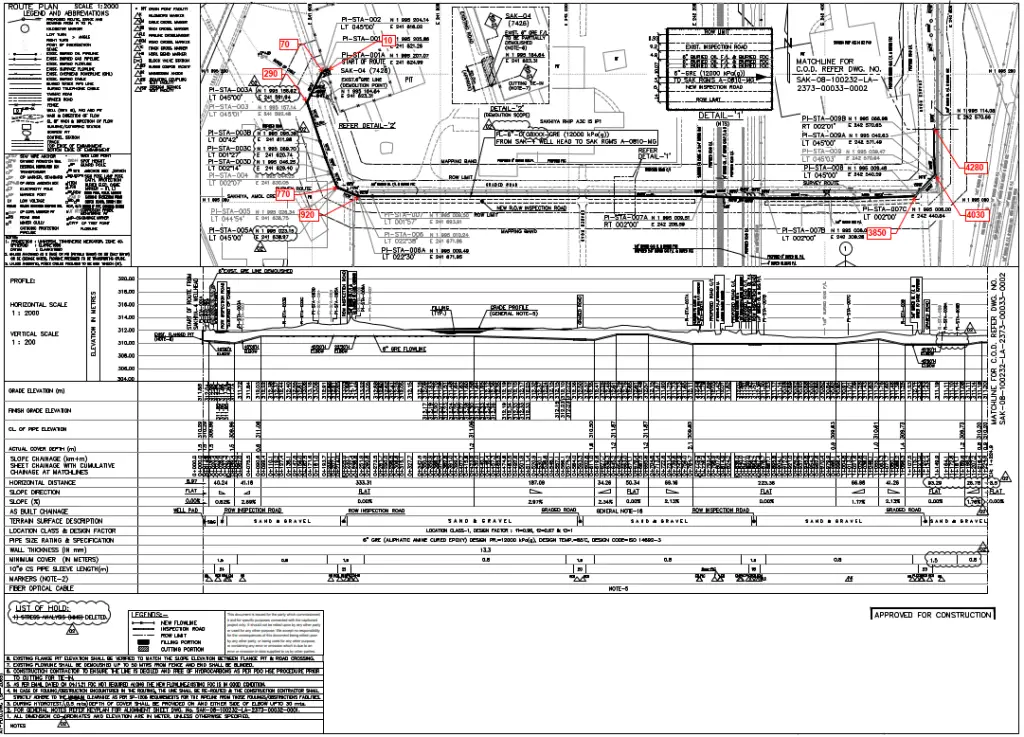
Benefits of Pipeline Alignment Drawing
There are several benefits of a pipeline alignment drawing or alignment sheet, including:
Visual representation: Alignment drawings provide a clear and concise visual representation of the pipeline route, making it easier for stakeholders to understand the proposed pipeline route and identify any potential conflicts or obstacles.
Early identification of issues: Alignment drawings are typically created during the planning and design stages of a pipeline project, which allows for early identification and resolution of any issues or conflicts before construction begins.
Cost savings: By identifying issues and conflicts early on, alignment drawings can help avoid costly design changes or construction delays that may occur if problems are identified during construction.
Improved safety: Alignment drawings can help ensure that the pipeline is installed in a safe and efficient manner, minimizing the risk of accidents or incidents during construction and operation.
Compliance with regulations: Alignment drawings are often required by regulatory agencies as part of the permitting process for pipeline construction, and can help ensure compliance with environmental and safety regulations.
Overall, alignment drawings are an important tool for ensuring the safe and efficient construction of underground pipelines and can help save time, money, and resources throughout the pipeline project lifecycle.
Reading a Pipeline Alignment Drawing
Reading a pipeline alignment drawing can be a complex process, but here are some basic steps to get started:
- Familiarize yourself with the drawing: Start by reviewing the entire alignment drawing to get an overall sense of the pipeline route and any key features or obstacles that may be present.
- Identify the scale and orientation: Determine the scale of the drawing, which will typically be indicated in the title block or legend. Also, identify the orientation of the drawing, which will indicate the direction of the pipeline route.
- Locate the pipeline route: Look for the line that represents the pipeline on the drawing. This line will typically be labeled with information such as the pipeline diameter, material, and depth.
- Identify key features: Look for any key features that may impact the pipeline route, such as roads, rivers, or other infrastructure. These features will typically be labeled on the drawing and may be shown in different colors or line styles.
- Review details: Review any additional details on the drawing, such as the location of valves, manholes, or other infrastructure. These details will typically be indicated with symbols or labels.
- Interpret data: Finally, use the information on the alignment drawing to interpret the pipeline route and identify any potential conflicts or issues that may need to be addressed.
Overall, reading a pipeline alignment drawing requires a careful review of the drawing and an understanding of the symbols, labels, and other information presented. It is important to have a clear understanding of the pipeline project requirements and goals, as well as any regulatory requirements that may impact the pipeline route.
Generating Pipeline Alignment Sheets
Generating pipeline alignment sheets typically involves several steps, including:
Gathering data: Collect all relevant data related to the pipeline project, such as project goals, regulatory requirements, topographical maps, and any other relevant information.
Creating a base map: Use the topographical maps and other data sources to create a base map that accurately depicts the area where the pipeline will be installed.
Drawing the pipeline route: Using CAD software or another drawing tool, create a drawing of the pipeline route that includes information such as the diameter, material, and depth of the pipeline. This drawing should also include any relevant details such as the location of valves, manholes, or other infrastructure.
Adding details: Once the basic pipeline route has been drawn, add additional details such as the location of key features that may impact the pipeline route, such as roads, rivers, or other infrastructure.
Reviewing and refining: Review the alignment sheet to ensure that it accurately represents the pipeline route and any relevant details. Make any necessary refinements or adjustments to ensure that the alignment sheet meets project goals and regulatory requirements.
Finalizing the alignment sheet: Once the alignment sheet is complete, finalize the drawing by adding a title block, legend, and any other required information. Save the alignment sheet in the appropriate file format for use in the pipeline project.
Overall, generating pipeline alignment sheets requires a careful review of the project goals and requirements, as well as an understanding of the technical drawing tools and software necessary to create an accurate and comprehensive alignment sheet.
Information required for Alignment Drawing
To generate a pipeline alignment drawing, several types of information are typically required. Here are some of the key types of information needed:
Pipeline route: Information about the proposed pipeline route is essential, including the length of the pipeline, the starting and ending points, and any deviations or changes in direction along the way.
Pipeline specifications: Details about the pipeline itself are important, including the diameter, material, and depth of the pipeline. Other specifications such as the wall thickness, coating, and corrosion protection may also be relevant.
Topographical data: Accurate topographical data is needed to ensure that the pipeline route is feasible and to identify any potential obstacles or challenges that may need to be addressed. This includes data on terrain, vegetation, waterways, and any other relevant features.
Infrastructure information: Information about the existing infrastructure that may impact the pipeline route, such as roads, bridges, and other utilities, is important to consider when generating an alignment drawing.
Environmental data: Data on the local environment and any potential environmental impacts of the pipeline project are essential for regulatory compliance and to ensure that the pipeline is installed in an environmentally responsible manner.
Regulatory requirements: Knowledge of local, state, and federal regulations related to pipeline construction is essential to ensure that the pipeline alignment drawing meets all necessary regulatory requirements.
Overall, generating a pipeline alignment drawing requires a thorough understanding of the pipeline project goals and requirements, as well as access to accurate and comprehensive data about the proposed pipeline route and surrounding environment.
Online Course on Pipeline Alignment Drawing
To get a better insight into pipeline alignment drawings, I recommend the following online course for you:


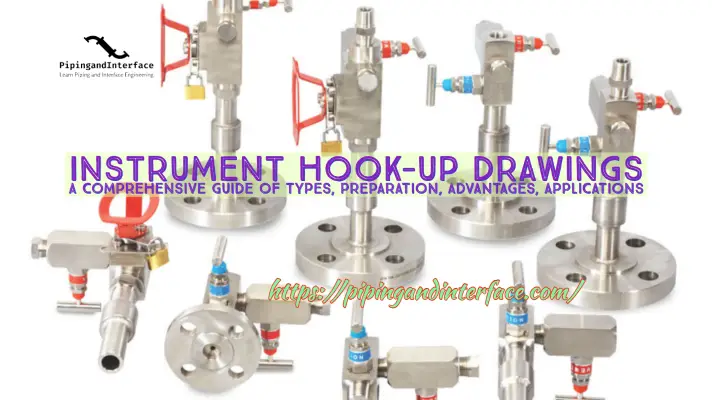
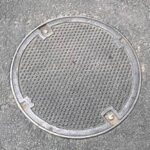
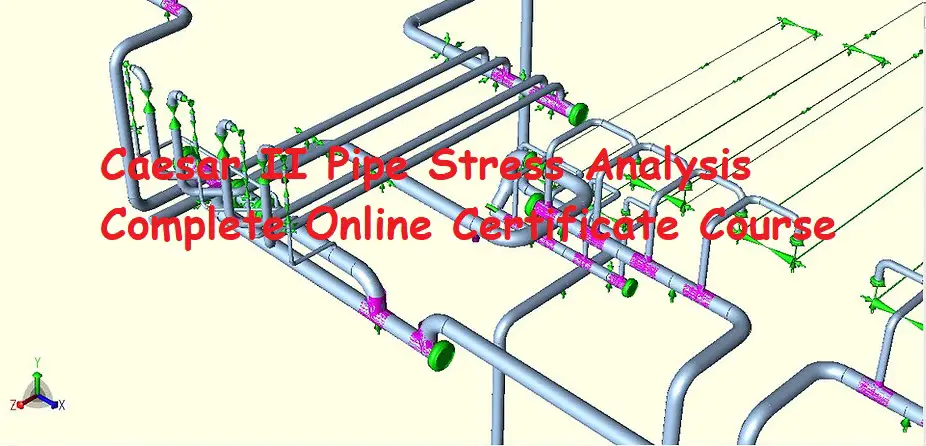
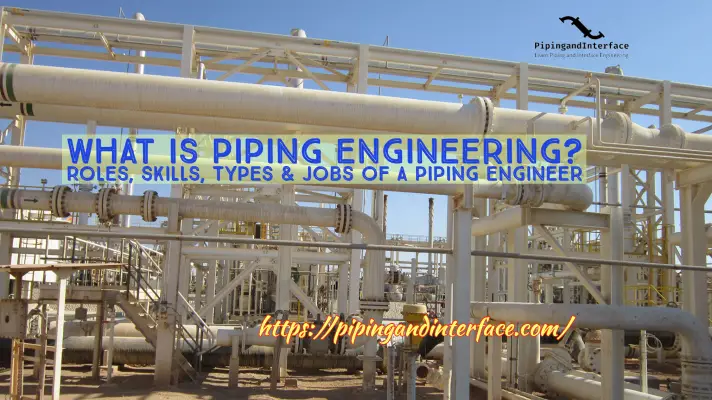
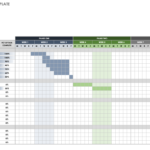
Hello Mr. Anup Kumar,
I want to know about how to calculate the Hydrotest Pressure of at low point and high point of the pipeline as per alignment sheet?
and
how to calculate the pressure difference when elevation changes?
seeking for your kind response.